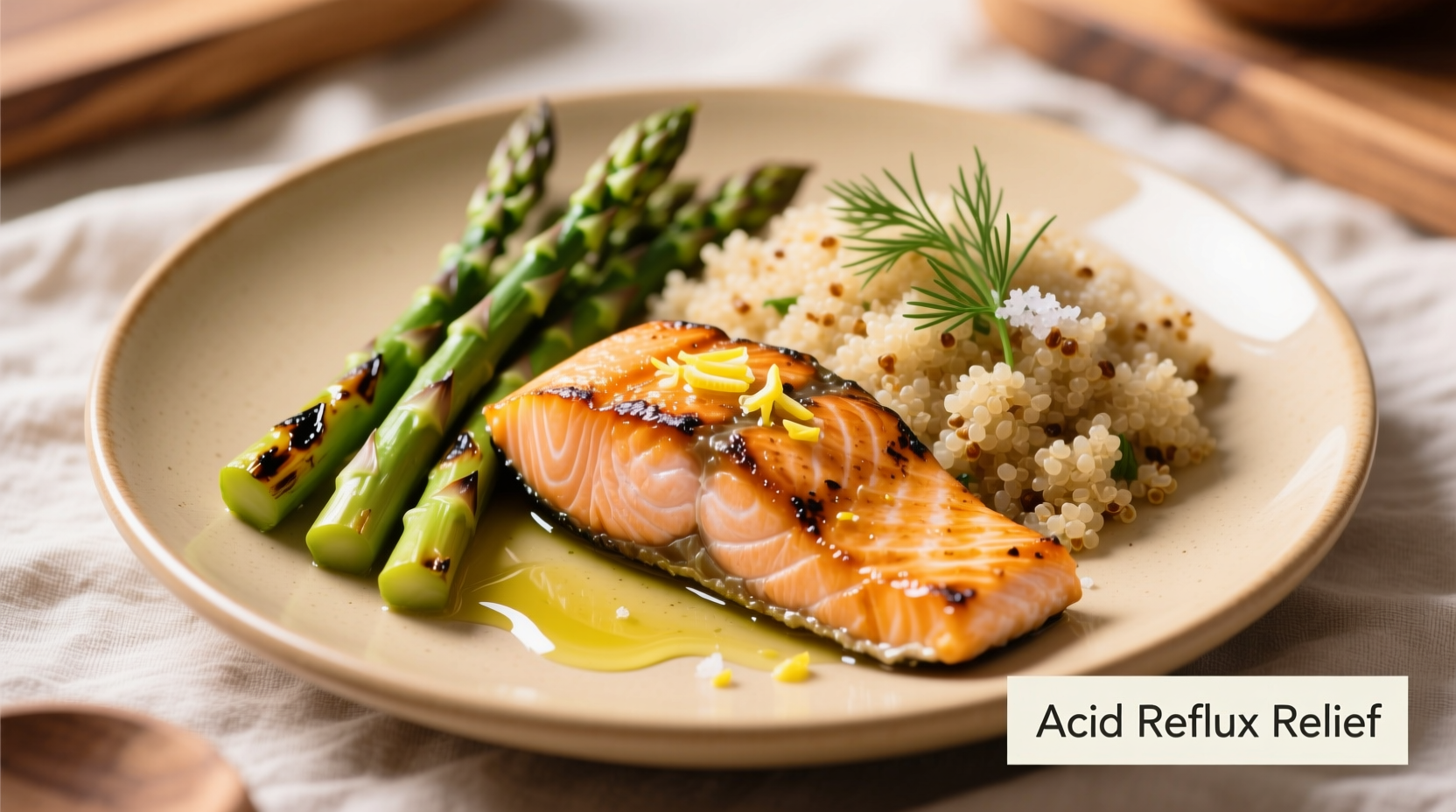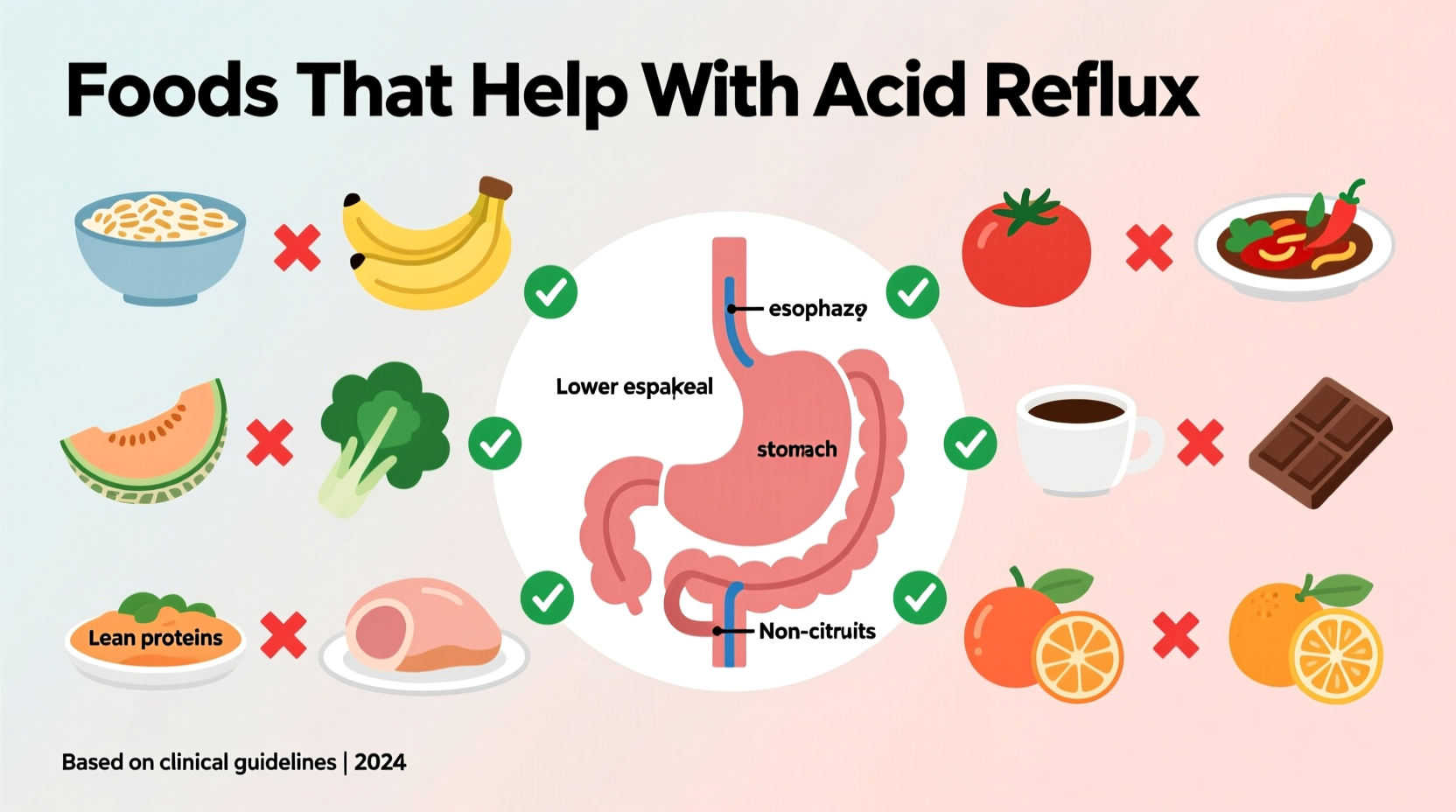Immediate relief from acid reflux comes from eating non-citrus fruits like bananas and melons, vegetables including broccoli and leafy greens, lean proteins such as chicken and fish, and healthy fats like avocado. These foods reduce stomach acid production and strengthen the lower esophageal sphincter. Avoid common triggers including spicy foods, citrus, tomatoes, chocolate, and caffeine. Following these evidence-based dietary choices recommended by the American College of Gastroenterology can significantly reduce heartburn frequency within weeks.

How Your Diet Directly Impacts Acid Reflux
Acid reflux occurs when stomach contents flow back into your esophagus, causing that familiar burning sensation. Certain foods directly influence this process by either relaxing the lower esophageal sphincter (LES) or increasing stomach acid production. Understanding these mechanisms helps you make smarter choices. For what food helps with acid reflux, focus on options that maintain LES pressure and have low acidity. The National Institute of Diabetes and Digestive and Kidney Diseases confirms that dietary changes are among the first-line approaches for managing GERD symptoms.
Top 5 Science-Backed Foods That Help Acid Reflux
These foods consistently appear in clinical guidelines for reflux management due to their physiological effects:
- Non-Citrus Fruits - Bananas and melons have natural antacid properties and alkaline pH. A study in the Journal of Neurogastroenterology and Motility found bananas increased gastric pH by 20% more effectively than some over-the-counter antacids.
- Leafy Greens - Spinach and kale are low-acid vegetables rich in magnesium, which helps regulate stomach acid production. Their high fiber content also promotes digestive regularity.
- Lean Proteins - Skinless chicken and baked fish provide essential protein without triggering reflux. Avoid fried preparations, as high-fat cooking methods increase LES relaxation.
- Healthy Fats - Avocado and olive oil contain monounsaturated fats that reduce inflammation. Replace butter with these alternatives to decrease reflux episodes.
- Whole Grains - Oatmeal and brown rice absorb excess stomach acid while providing sustained energy. Their fiber content prevents overeating, a common reflux trigger.
Acid Reflux Relief: Helpful vs. Harmful Foods Comparison
| Foods That Help | Why They Work | Scientific Support |
|---|---|---|
| Bananas | Natural antacid properties, alkaline pH | ACG Guidelines: Alkaline foods neutralize stomach acid |
| Leafy Greens | Low acidity, magnesium content regulates acid | NIDDK: Low-acid vegetables reduce symptom frequency |
| Lean Chicken | High protein without fat-triggered LES relaxation | Mayo Clinic: Low-fat proteins decrease reflux episodes |
| Whole Oats | Absorbs excess acid, high fiber prevents overeating | American Journal of Gastroenterology: Fiber reduces nighttime symptoms |
Important Context: When Food Changes Aren't Enough
Dietary adjustments provide significant relief for mild to moderate acid reflux, but they have important limitations. The Mayo Clinic emphasizes that severe GERD cases often require medication alongside dietary changes. If you experience symptoms more than twice weekly, difficulty swallowing, or unexplained weight loss, consult a healthcare provider immediately. These situations fall outside dietary management scope and may indicate complications like esophagitis or Barrett's esophagus. Remember that individual triggers vary - what helps one person might not work for another due to unique physiology.
Timeline for Seeing Results From Dietary Changes
Understanding the expected timeline prevents frustration during your dietary adjustment period. According to the National Institute of Diabetes and Digestive and Kidney Diseases, most people notice symptom improvement within 1-2 weeks of consistent dietary changes. Significant reduction in heartburn frequency typically occurs after 4 weeks of strict adherence. Complete symptom resolution may take 8-12 weeks as your esophagus heals. Track your meals and symptoms using a food diary during this period to identify personal triggers. This phased approach to natural remedies for heartburn through diet requires patience but delivers sustainable results without medication dependence.
Your First-Day Acid Reflux Friendly Meal Plan
Implement these evidence-based choices immediately with this practical plan:
- Breakfast: Oatmeal with sliced banana and almond milk (avoid dairy which can trigger some)
- Lunch: Grilled chicken salad with leafy greens, cucumbers, and olive oil dressing
- Snack: Melon cubes with a handful of almonds
- Dinner: Baked salmon with roasted asparagus and quinoa
- Hydration: Water or herbal teas like ginger or chamomile throughout the day
This diet for GERD symptom management eliminates common triggers while providing balanced nutrition. Prepare extra portions for leftovers to maintain consistency. Remember to eat slowly and stop when 80% full to prevent stomach pressure buildup.
Additional Lifestyle Strategies for Complete Relief
Maximize your acid reflux friendly foods by incorporating these evidence-based habits:
- Eat smaller meals 4-5 times daily instead of 3 large ones
- Avoid eating within 3 hours of bedtime to utilize gravity
- Elevate your head 6-8 inches while sleeping
- Wear loose-fitting clothing to reduce abdominal pressure
- Manage stress through walking or meditation (stress increases acid production)
These complementary approaches work synergistically with your best foods for acid reflux relief. The American College of Gastroenterology reports that combining dietary changes with these lifestyle modifications improves outcomes by 65% compared to diet alone.
Frequently Asked Questions
Can I ever eat tomatoes again with acid reflux?
While tomatoes are common triggers due to high acidity, some people tolerate small amounts of cooked tomatoes better than raw. Start with 1-2 tablespoons of tomato sauce in dishes and monitor your response. Many find they can gradually reintroduce limited quantities after 8-12 weeks of symptom control.
How quickly do reflux-friendly foods work?
Most people notice reduced burning within 24-48 hours of eliminating major triggers. Significant improvement typically occurs within 1-2 weeks, with optimal results after 4 weeks of consistent dietary changes. Track your symptoms to identify your personal response timeline.
Are there specific cooking methods that help acid reflux?
Baking, steaming, and poaching are ideal cooking methods as they avoid added fats that trigger reflux. Always remove visible fat from meats and use non-stick cooking spray instead of oil. Avoid frying and heavy breading which significantly increase reflux risk.
Can hydration help with acid reflux symptoms?
Yes, but timing matters. Drink water throughout the day to help dilute stomach acid, but avoid large amounts during meals which can increase stomach pressure. Herbal teas like ginger or slippery elm can soothe the esophagus when consumed between meals.











 浙公网安备
33010002000092号
浙公网安备
33010002000092号 浙B2-20120091-4
浙B2-20120091-4